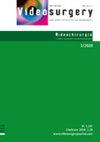The real occurrence of gastroesophageal reflux disease after sleeve gastrectomy – a prospective pH-monitoring study
IF 1.9
4区 医学
Q2 SURGERY
引用次数: 0
Abstract
IntroductionSleeve gastrectomy (SG) is currently the most frequently performed bariatric procedure in the world. However, the occurrence of gastroesophageal reflux disease (GERD) after SG remains controversial and questionable.
Aim
To determine the occurrence of GERD after SG using a pH-monitoring study.
Material and methods
This is a prospective study involving patients undergoing SG in one surgical centre. Inclusion criteria were eligibility for bariatric surgery, no symptoms of GERD, normal gastroscopy, and pH-monitoring before the surgery. Postoperative examinations were performed 6 months after surgery.
Results
A total of 38 patients were analysed in the study. The mean age was 44.9 years, and the mean preoperative BMI was 42.6 kg/m2. Before surgery, all patients had normal pH values. After surgery, mean acid exposure time (AET), number of refluxes, and DeMeester score increased statistically significantly (p < 0.001). 27 (71.1%) patients each had AET > 6%, but only 9 (23.7%) reported GERD symptoms and the need for PPIs. The correlation between AET and %TWL was moderate positive, and the correlation between DeMeester score and %TWL was low positive (p = 0.011, p = 0.014, respectively).
Conclusions
GERD after SG seems to be a significant problem. More than two-thirds of patients had de novo GERD after SG in pH-monitoring, but only one-quarter of them required PPIs.
袖带胃切除术后胃食管反流病的真实发生率--一项前瞻性 pH 监测研究
导言袖状胃切除术(SG)是目前世界上最常见的减肥手术。材料和方法这是一项前瞻性研究,涉及在一家外科中心接受袖带胃切除术的患者。纳入标准为符合减肥手术的条件、无胃食管反流症状、胃镜检查正常、术前接受过 pH 监测。术后 6 个月进行术后检查。平均年龄为 44.9 岁,术前平均体重指数为 42.6 kg/m2。手术前,所有患者的 pH 值均正常。手术后,平均酸暴露时间(AET)、反流次数和 DeMeester 评分均有显著的统计学增长(p < 0.001)。27名(71.1%)患者的AET均为6%,但只有9名(23.7%)患者出现胃食管反流症状,需要服用PPIs。AET 和 %TWL 之间的相关性为中度正相关,DeMeester 评分和 %TWL 之间的相关性为低度正相关(分别为 p = 0.011 和 p = 0.014)。超过三分之二的患者在SG术后通过pH值监测发现有新的胃食管反流病,但只有四分之一的患者需要服用PPIs。
本文章由计算机程序翻译,如有差异,请以英文原文为准。
求助全文
约1分钟内获得全文
求助全文
来源期刊
CiteScore
2.80
自引率
23.50%
发文量
48
审稿时长
12 weeks
期刊介绍:
Videosurgery and other miniinvasive techniques serves as a forum for exchange of multidisciplinary experiences in fields such as: surgery, gynaecology, urology, gastroenterology, neurosurgery, ENT surgery, cardiac surgery, anaesthesiology and radiology, as well as other branches of medicine dealing with miniinvasive techniques.

 求助内容:
求助内容: 应助结果提醒方式:
应助结果提醒方式:


